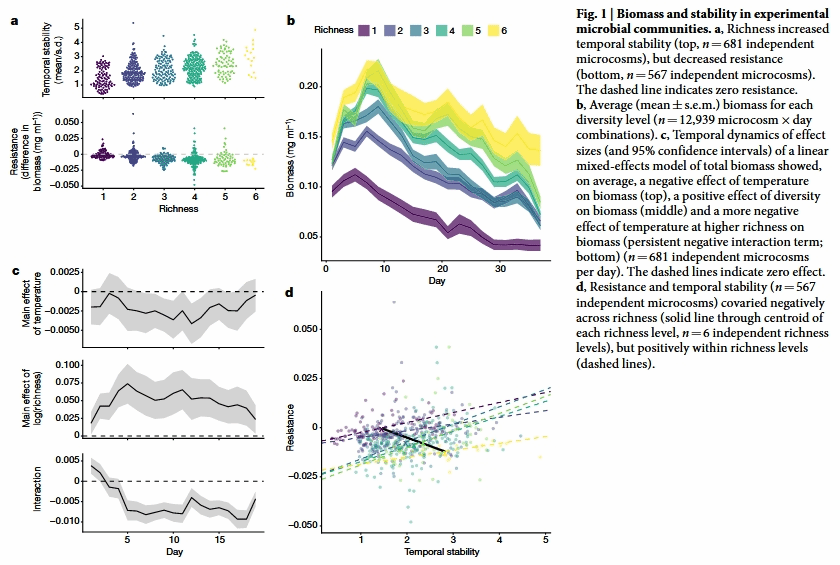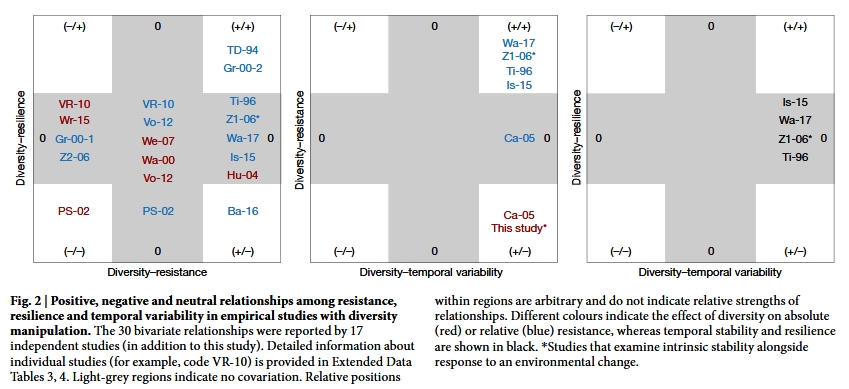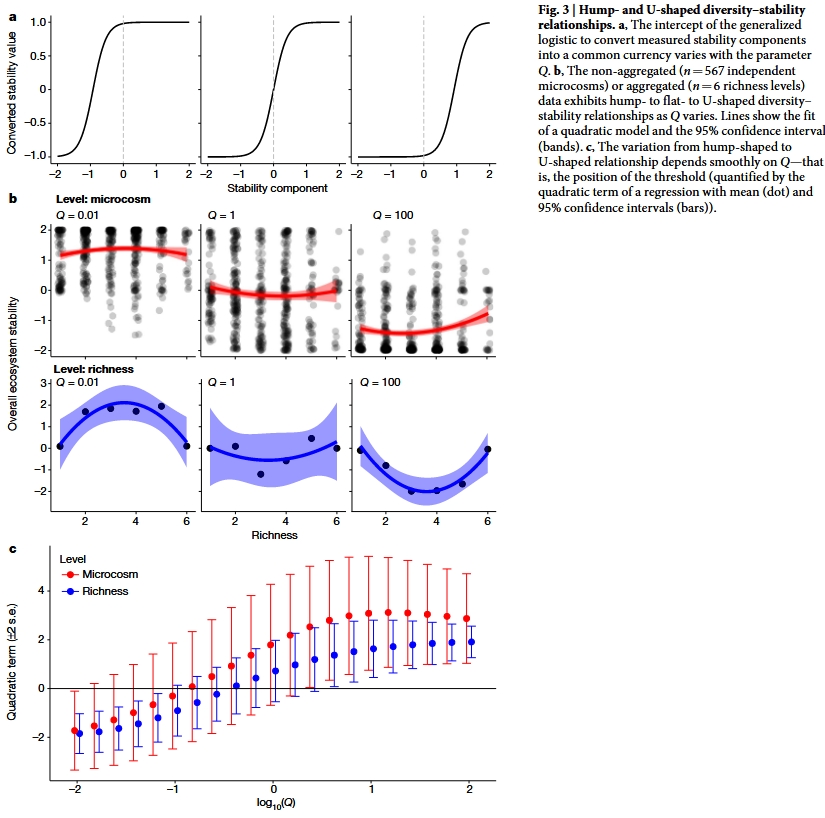文章信息:Frank Pennekamp, Mikael Pontarp, Andrea Tabi, Florian Altermatt, Roman Alther, Yves Choffat, Emanuel A. Fronhofer, Pravin Ganesanandamoorthy, Aurélie Garnier, Jason I. Griffiths, Suzanne Greene, Katherine Horgan, Thomas M. Massie, Elvira Mächler, Gian Marco Palamara, Mathew Seymour, & Owen L. Petchey. (2018). Biodiversity increases and decreases ecosystem stability. Nature, 563(7731), 109–112. https://doi.org/10.1038/s41586-018-0627-8
整理人:闫甲祺,2024级硕士研究生
整理时间:2025年1月24日
Abstract: Losses and gains in species diversity affect ecological stability1–7 and the sustainability of ecosystem functions and services8–13. Experiments and models have revealed positive, negative and no effects of diversity on individual components of stability, such as temporal variability, resistance and resilience2,3,6,11,12,14. How these stability components covary remains poorly understood15. Similarly, the effects of diversity on overall ecosystem stability16, which is conceptually akin to ecosystem multifunctionality17,18, remain unknown. Here we studied communities of aquatic ciliates to understand how temporal variability, resistance and overall ecosystem stability responded to diversity (that is, species richness) in a large experiment involving 690 micro-ecosystems sampled 19 times over 40 days, resulting in 12,939 samplings. Species richness increased temporal stability but decreased resistance to warming. Thus, two stability components covaried negatively along the diversity gradient. Previous biodiversity manipulation studies rarely reported such negative covariation despite general predictions of the negative effects of diversity on individual stability components3. Integrating our findings with the ecosystem multifunctionality concept revealed hump- and U-shaped effects of diversity on overall ecosystem stability. That is, biodiversity can increase overall ecosystem stability when biodiversity is low, and decrease it when biodiversity is high, or the opposite with a U-shaped relationship. The effects of diversity on ecosystem multifunctionality would also be hump- or U-shaped if diversity had positive effects on some functions and negative effects on others. Linking the ecosystem multifunctionality concept and ecosystem stability can transform the perceived effects of diversity on ecological stability and may help to translate this science into policy-relevant information.
摘要:物种多样性的损失和收益影响生态稳定1-7以及生态系统功能和服务的可持续性8-13。实验和模型揭示了多样性对稳定性各个组成部分的积极,负和没有影响,例如时间变异性,抗性和弹性2,3,6,11,12,14。这些稳定性成分如何保持不足15。 同样,多样性对整体生态系统稳定性的影响16在概念上类似于生态系统多功能性17,18,仍然未知。在这里,我们研究了水生睫毛群社区,以了解时间可变性,阻力和整体生态系统稳定性如何响应多样性(即物种丰富度),涉及690个微型生态系统在40天内采样19次,在40天内取样了19次,导致了12,939种采样。物种丰富度提高了时间稳定性,但对变暖的抵抗力降低。因此,两个稳定成分沿多样性梯度呈负相协变。以前的生物多样性操纵研究很少报道如此负协方差,尽管一般地预测了多样性对个体稳定性成分的负面影响3。将我们的发现与生态系统多功能概念相结合,揭示了多样性对整体生态系统稳定性的驼峰和U形影响。也就是说,当生物多样性低时,生物多样性可以提高整体生态系统的稳定性,并在生物多样性较高时降低它,或者与U形关系相反。如果多样性对某些功能产生积极影响和对其他功能的负面影响,多样性对生态系统多功能性的影响也将是驼峰或U形的影响。将生态系统多功能概念和生态系统稳定性联系起来可以改变多样性对生态稳定性的感知影响,并可能有助于将这一科学转化为与政策相关的信息。
1. 研究背景
2. 研究意义
3. 研究方法
-
实验设计:研究者在690个微生态系统中进行了为期40天的实验,涉及19次采样,总采样量达12,939次。实验中对温度(15°C至25°C)和物种丰富度(1至6种)进行了因子化操作。
-
稳定性指标:计算了两个稳定性组成部分:抗性(总生物量对温度变化的响应)和时间稳定性(生物量的时间变异性的倒数)。
-
数据分析:使用线性混合效应模型分析了物种丰富度、温度及其交互作用对总生物量的影响;通过主轴回归分析评估了抗性和时间稳定性之间的协变关系。
-
整体生态系统稳定性评估:将标准化后的稳定性组成部分通过广义逻辑函数转换为统一的度量单位,以评估整体生态系统稳定性。
4. 研究主要结论
-
物种丰富度对稳定性的影响:物种丰富度的增加提高了总生物量的时间稳定性,但降低了对温度变化的抗性。
-
稳定性组成部分的协变:抗性和时间稳定性在物种丰富度梯度上呈负相关,但在单一物种丰富度水平内呈正相关。
-
整体生态系统稳定性:物种丰富度对整体生态系统稳定性的影响呈现非单调关系,即在低物种丰富度时增加稳定性,而在高物种丰富度时降低稳定性,或呈现U形关系。这种非单调关系取决于稳定性组成部分之间的协变关系以及转换函数的参数选择。
5. 研究展望
-
机制探索:未来的研究需要进一步探索导致稳定性组成部分之间协变关系的具体机制,如响应多样性、生态位互补性等,以及这些机制如何在不同的生态系统和环境条件下发挥作用。
-
数据改进:需要更多的实验和观测数据来验证和细化本研究中发现的非单调关系,特别是在不同的生态系统类型和环境梯度下。
-
政策应用:将生物多样性对生态系统稳定性的复杂影响转化为政策相关的信息,有助于制定更有效的生态保护和资源管理策略,以应对生物多样性变化对生态系统服务的影响。
6. 研究主要图表:

01 实验微生物群落的生物量和稳定性

02 在多样性操纵的经验研究中,抵抗力,弹性和时间变化之间的正面,负和中性关系

03 驼峰和U形多样性 - 稳定关系
原文链接:https://www.nature.com/articles/s41586-018-0627-8
原文转引:https://mp.weixin.qq.com/s/zNTEmNQ7ADk_CWLBSoCW9g